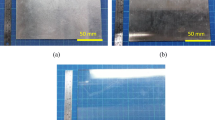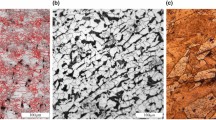Abstract
This article describes a single transducer ultrasonic imaging method based on ultrasonic velocity measurement that eliminates the effect of thickness variation in the images of ceramic and composite plate samples. The method is based on using a reflector located behind the sample and acquiring echoes off the sample and reflector surfaces in two scans. As a result of being thickness-independent, the method isolates ultrasonic variations due to material microstructure. Its use can result in significant cost savings because the ultrasonic image can be interpreted correctly without the need for precision thickness machining during nondestructive evaluation stages of material development. Velocity images obtained using the thickness-independent methodology are compared with apparent velocity maps and c-scan echo peak amplitude images for monolithic ceramic (silicon nitride), metal matrix composite and polymer matrix composite materials having thickness and microstructural variations. It was found that the thickness-independent ultrasonic images reveal and quantify correctly areas of global microstructural (pore and fiber volume fraction) variation due to the elimination of thickness effects. A major goal achieved in this study was to move the thickness-independent imaging technology out of the lab prototype environment and into the commercial arena so that it would be available to users worldwide.
Access this article
We’re sorry, something doesn't seem to be working properly.
Please try refreshing the page. If that doesn't work, please contact support so we can address the problem.
Similar content being viewed by others
References
A. S. Birks, R. E. Green, and P. McIntire, Nondestructive Testing Handbook, 2nd Ed. Vol. 7 Ultrasonic Testing (American Society for Nondestructive Testing, 1991), pp. 225, 227<230, 387<390, 405.
M. Bashyam, Thickness Compensation and Dynamic Range Improvement For Ultrasonic Imaging of Composite Materials, Proc. of the 17th Annual Review of Progress in Quantitative Nondestructive Evaluation, La Jolla, CA, July 15<20, 1990, Vol. 10A (Plenum Press, 1991), pp. 1035<1042.
J. J. Gruber, J. M. Smith, and R. H. Brockelman, Ultrasonic velocity c-scans for ceramic and composite material characterization, Mater. Eval. 46(1):90–96 (1988).
B. D. Sollish, Ultrasonic Velocity and Thickness Gage, United States Patent no. 4,056,970 (Nov. 8, 1977).
L. Pichè, Ultrasonic velocity measurement for the determination of density in polyethylene, Polym. Eng. Sci. 24(17):1354–1358 (1984).
I. Y. Kuo, B. Hete, and K. K. Shung. A novel method for the measurement of acoustic speed, J. Acoust. Soc. Am. 88(4):1679–1682 (1992).
D. K. Hsu and M. S. Hughes, Simultaneous ultrasonic velocity and sample thickness measurement and application in composites. Part 1, J. Acoust. Soc. Am. 92(2):669–675 (1992).
V. Dayal, An automated simultaneous measurement of thickness and wave velocity by ultrasound, Exp. Mech., 32(2):197–202 (1992).
M. S. Hughes and D. K. Hsu, An automated algorithm for simultaneously producing velocity and thickness images, Ultrasonics 32(1):31–37 (1994).
D. J. Roth et al., Commerial Implementation of Ultrasonic Velocity Imaging Methods via Cooperative Agreement Between NASA, Lewis Research Center and Sonix, Inc. NASA TM-107138 (1996).
R. P. Bevington, Data Reduction and Uncertainty Analysis for the Physical Sciences, Chap. 4 (McGraw-Hill, New York, 1969).
D. R. Hull, H. E. Kautz, and A. Vary, Measurement of ultrasonic velocity using phase-slope and cross-correlation methods, Mater. Eval. 43(1):1455–1460 (1985).
D. J. Roth et al., Quantitative mapping of pore fraction variations in silicon nitride using an ultrasonic contact scan technique, Res. Nondestr. Eval. 6:125–168 (1995).
Ultrasonic c-scan Users Guide, V3.10d, Sonix, Inc., 8700 Morrissette Drive, Springfield, VA 22152 (Jan. 1995).
Author information
Authors and Affiliations
Additional information
The method has been implemented on commercially-available ultra-sonic can systems manufactured by Sonix, Inc. via a formal technology transfer agreement between NASA and Sonix.
Rights and permissions
About this article
Cite this article
Roth, D.J. Using a single transducer ultrasonic imaging method to eliminate the effect of thickness variation in the images of ceramic and composite plates. J Nondestruct Eval 16, 101–120 (1997). https://doi.org/10.1007/BF02683877
Received:
Revised:
Issue Date:
DOI: https://doi.org/10.1007/BF02683877




